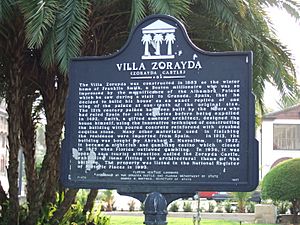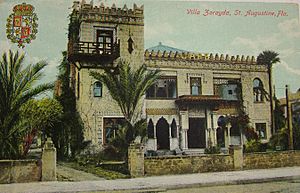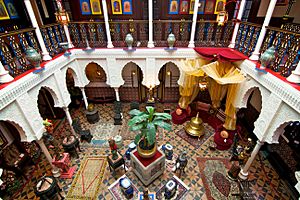Villa Zorayda facts for kids
Quick facts for kids |
|
|
Villa Zorayda
|
|
 |
|
| Location | St. Augustine, Florida |
|---|---|
| Architect | Franklin W. Smith |
| Architectural style | Moorish Revival |
| NRHP reference No. | 93001002 |
| Added to NRHP | September 23, 1993 |
The Villa Zorayda is a unique house located at 83 King Street in St. Augustine, Florida. It is also known as the Zorayda Castle. A wealthy man from Boston named Franklin W. Smith built it in 1883. He used it as his winter home.
Smith was inspired by the amazing Alhambra Palace in Granada, Spain. This palace was built in the 12th century and has a special Moorish design. Franklin Smith named his new home "Villa Zorayda" after a princess in a famous book. The book was called Tales of the Alhambra by Washington Irving.
In 1913, Smith sold the building and some of his art. It was bought by Abraham Mussallem, who sold rugs and old treasures. On September 23, 1993, the Villa Zorayda became a National Historic Place in the United States. Today, the Mussallem family still owns the Villa Zorayda Museum. It holds the original art and antique collections from both Franklin Smith and Abraham Mussallem.
History of Villa Zorayda
Franklin W. Smith was not a professional architect, but he loved designing buildings. He was one of the first people to experiment with building homes using poured concrete. His winter home, Villa Zorayda, was the first house in Florida built in the Moorish Revival style. It was also the first building in St. Augustine made from poured concrete.
Smith's special concrete mix used crushed coquina shells. He poured the concrete in layers. This building method was later used by Henry Morrison Flagler. Flagler was a partner in Standard Oil and a big developer in Florida. He used Smith's ideas to build his large hotels and churches nearby. The Villa Zorayda is also seen as one of the first examples of "fantasy architecture" in Florida. This means it looked like something from a storybook.
Franklin Smith was an early member of the Republican Party. He even danced with his wife at Abraham Lincoln's first ball as president in 1861. He also helped start the Boston YMCA. Smith worked on many projects to improve public life throughout his long life. He is buried in the Mount Auburn Cemetery in Cambridge, Massachusetts. Another large building Smith built in St. Augustine is the Casa Monica Hotel. It is just one block east of Villa Zorayda. Henry Flagler later bought this hotel and renamed it the Cordova Hotel.
How Villa Zorayda Was Used
Over the years, the Villa Zorayda has been used for different things. Besides being a private home, it was once a restaurant. It was also a nightclub and a place for gambling. For a time, it even served as a hotel.
The building was closed for a while for repairs starting in 2003. It reopened to the public in 2008. Visitors can now take audio tours to learn about the building. These tours are available in English, Spanish, and French. They tell the story of the building, its importance in St. Augustine, and all about the old art and treasures inside. The museum is open every day.
The Collection Inside
The Villa Zorayda Museum has many beautiful details inside. One of the most special features is the plaster work. It is made with ground alabaster, which is a soft stone. This plaster work looks just like the designs found in the Alhambra Palace in Spain. These designs are called traceries or arabesques. They are copies of the walls in the Alhambra Palace.
Above the main entrance, there is a saying written in Arabic. It says, "There is no conqueror but God." This is the same phrase found in the Alhambra. The building's design also includes many other fine details. There are hand-painted wood panels and tiles. You can see beautifully designed fireplaces and doorways. The windows have unique geometric shapes and colorful stained glass.
The museum's collection also includes many interesting items. There are brass lamps with intricate patterns from Damascus and other parts of the Middle East. You can see beautiful Oriental rugs, sculptures, and carved furniture. There are also decorative tiles and ancient Egyptian artifacts.
See also
 In Spanish: Villa Zorayda para niños
In Spanish: Villa Zorayda para niños







